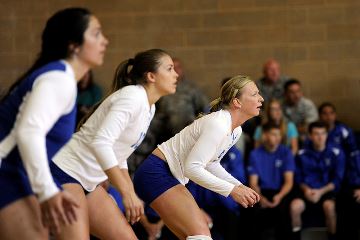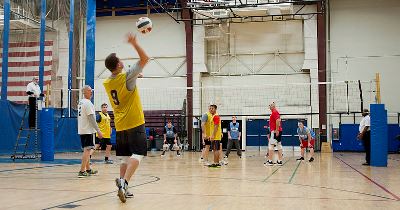Sports
Volleyball: Strategy and Team Play
Back to Volleyball
Volleyball Player
Positions Volleyball Rules Volleyball
Strategy Volleyball
Glossary
 Source: US Air Force
Source: US Air Force
The Volleyball Serve
Each point starts with a serve. Having a strong volleyball serve and service strategy can help your team greatly. How the ball is hit, where it is hit, and which player you hit it to all need to be considered.
It is important to practice your serve. Pick a style you want to master and then practice it to perfection. It helps to practice in scrimmages or under pressure as well.
Most beginners will serve the ball underhand to make sure they get the ball in play. Expert volleyball players will serve the ball overhand, however. Some players work on getting a topspin on the ball so it will dive quickly into the court. Other players will hit the ball with no spin making it float and possibly change directions in the air erratically. To get more speed and angle on the serve, some players employ a jump serve where they toss the ball in the air and jump to hit the ball at a high point.
Volleyball Passing and Setting
Passing and setting are important skills and also important in strategy.
The pass is the first hit in the sequence. It may be a bump with the forearms or a hit with the fingers. The idea is to get control of the ball. Get the ball in the air to a setter with enough control so the setter can focus on making a good set and not worry about digging or getting to the ball.
The set is the next hit in the sequence. A set is typically made with the fingertips to help control the positioning of the ball for the attack. Strategies include forward or backward setting or dumping the volleyball quickly over the net to an open spot before the opponent is ready.
Volleyball Attacking
The final shot in the sequence is the attack. The goal of the attack shot is to hit a winning ball that lands into the opponent's court. Typically this is a spike or hard shot where the attacker jumps and hits the set ball down hard into the opponent's side. Footwork and quick steps prior to the jump can be key in hitting a winning shot. The attack doesn't have to be a spike, however. Other effective shots can be dinks, dunks, and dips where the ball is hit quickly over or around the blockers and into an open space on the court.

Serving the ball
Source: US Air Force
Blocking is an essential part of volleyball strategy. Players try to block the attack of the opponent and send the ball directly back into the others teams court. Deciding when to block and when to back off and try to pass and set the attack shot is key to strategy. Often teams and players will fake one and do the other to throw off the attacker.
Formations
The main differentiation in volleyball formations is in the number of setters vs. the number of attackers. There are three main formations used by most teams. They are 4-2 6-2 and 5-1. Beginners typically use a 4-2 where there are 4 attackers and 2 setters. Most advanced teams will use a 5-1 formation with a single setter and 5 attackers.
Volleyball Player
Positions Volleyball Rules Volleyball
Strategy Volleyball
Glossary
Back to Volleyball

